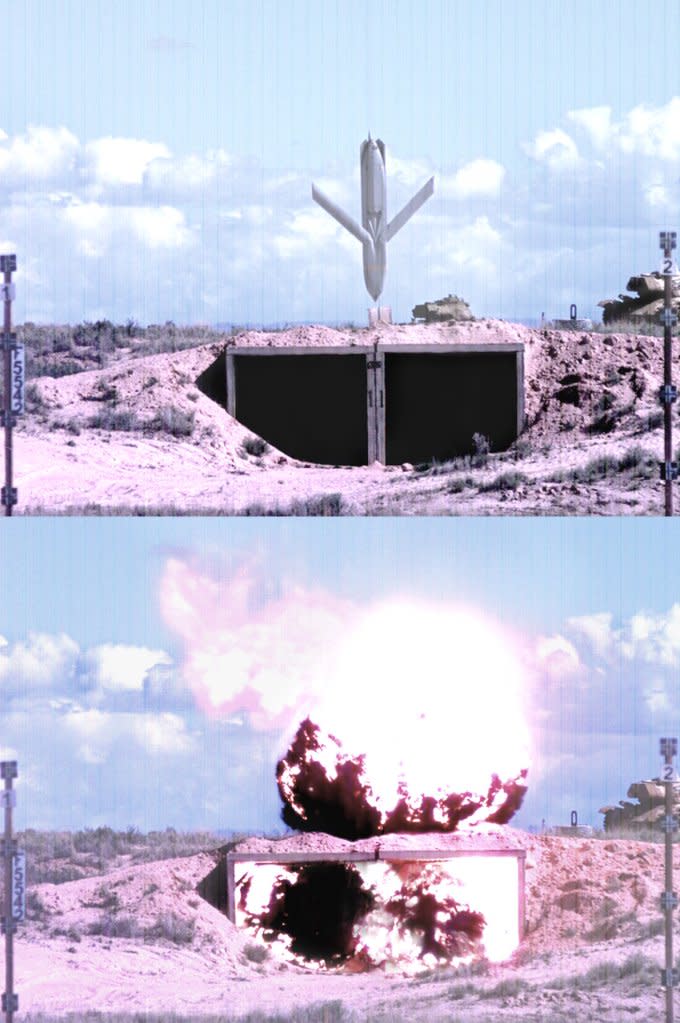Lockheed Martin has provided new details about their AGM-158 Extreme Range (XR) variant of the proven Joint Air-to-Surface Standoff Missile (JASSM) family of munitions. JASSM now underpins much of the USAF’s deep strike capabilities and a growing portion of the Navy and Air Force’s air-launched anti-ship capabilities via its sister, the Long-Range Anti-Ship Missile (LRASM). We have known the XR version of this weapon has been in development for some time, but this is the first time we have seen it and have gotten official details about its configuration. This unveiling came at the Air Force Association’s biggest gathering of the year — Air, Space & Cyber 2024 — outside of Washington, D.C., an event widely used for just this kind of official disclosures and product promotions.
John Hill, Lockheed Martin’s general manager for air dominance and strike weapons said the following this morning about the AGM-158 XR:
“I would say that the ‘158 XR’ really is a story of innovation and anticipating the needs of the warfighters. It leverages an existing production line, production processes… When we think of XR, think of that as extreme range. What it really does is it stretches the existing JASSM and LRASM family, that outer mold line, to give us more fuel, essentially, and that buys us the range that we need and that the warfighters need.”
“It leverages modularity. So while we’re in doing modifications, we’re going digital. We’re leveraging the existing mission planning structure along with the existing software architecture. And as you know, JASSM or LRASM benefit from inline upgrades and fixes as they come down the production line. So for me, being part of a production line where you can incorporate changes that the warfighters ask for in stride is a pretty powerful thing. So this weapon leverages all of those really great things, and it’s a great option for the Air Force to consider for the future.”

The XR clearly sports the familiar trapezoidal cross-section and low-observable shaping of the JASSM and LRASM, but this new variant is substantially larger via a stretched fuselage. The XR is a substantial leap in proportions compared to its predecessors, allowing it carry much more gas, as well as a sizable 1,000-pound-class warhead.
As it sits now, the land attack part of the AGM-158 family, which started service over two decades ago, is made up of the following:
-
AGM-158A JASSM – baseline variant (no longer in production).
-
AGM-158B JASSM-ER – baseline extended range variant.
-
AGM-158B-2 JASSM-ER – “replaces obsolete components and provides a new electronic fuze, a new Global Positioning System (GPS) receiver, an upgraded Missile Control Unit (MCU), and enhanced software.” (according to the U.S. Air Force’s Fiscal Year 2025 budget proposal); “Obsolescence upgrade; increased computing capability, C++ missile control software. Foundational system upgrade for follow on 158B-3 and 158D variants.” (from a declassified Pentagon Modernized Selected Acquisition Report).
-
AGM-158B-3 JASSM-ER – M-code GPS capability (still in development).
-
AGM-158D JASSM-ER – “Weapon Data Link (WDL) capability to re-target the missile, post-launch, against relocatable or higher priority targets during mission execution.” (again per the Air Force’s proposed Fiscal Year 2025 budget; still in development).


On top of this evolutionary roster is the anti-ship derivative of the JASSM, the aforementioned AGM-158C Long-Range Anti-Ship Missile (LRASM), which leverages nearly the identical airframe as earlier variants of the missile, but is optimized for attacking highly-defended ships in dense and very hostile combat environments. It includes an imaging infrared (IIR) seeker optimized for spotting, classifying, and precisely attacking vessels, as well as the ability to detect electromagnetic threats and either avoid them or use those signatures to help home in on and destroy them. A data link is also supposedly a key option, allowing LRASM to communicate in a networked battlespace, a feature that stands to vastly increase its lethality. This could also allow the missiles to talk to each other, providing cooperative swarming capabilities that can react to their environment and allow the missiles to autonomously work together to prosecute a target set or mission in conjunction with one another. An extended-range version of LRASM, also known as AGM-158C-3, which also incorporates other upgrades, is now in development.


Lockheed Martin is specifically calling this new cruise missile variant AGM-158 XR, not the JASSM XR, as its vastly extended range could be adapted to the LRASM side of the portfolio, as well as the JASSM one. This would provide a survivable, very long-range maritime strike capability against highly-defended ships, which could be a critical capability to degrading China’s anti-access/area-denial bubble that extends far off their shores. Further adapting and evolving existing munitions for this purpose has become a top priority and we are seeing the fruits of some of those efforts emerge as of late.
The original A variant of the JASSM is thought to have a range of well over 230 miles (with some sources stating it is over 300 miles), while the ER variant boosts that dramatically to over 500 miles (around 575 miles by some accounts). The XR is thought to be able to reach Tomahawk-like distances of around 1,000 miles. This vastly expands the weapon’s flexibility and unpredictability, while providing drastically increased survivability for its launch platforms, which are primarily aircraft, from fighters to bombers, and, in the future, even possibly cargo aircraft. It’s also possible a ground-launched capability could emerge, too. LRASM has already been tested in the Mk 41 naval vertical launch system (VLS), as well.
It’s also possible that AGM-158 XR could trade warhead size to pack even more fuel inside, extending its range even further, although weight and balance issues may restrict just how much flexibility exists in this regard.


Lockheed’s Michael Rothstein, vice president of air weapons and sensors, laid out a bit of the value proposition, including how this missile could reduce critical tanking requirements, during the Q&A with reporters today:
“You know, operationally, I would kind of put it in three things I think this brings relevance to… the first is a threat. We all know, the threats continue to evolve, and ranges continue to grow… When you can have more standoff [range] and still do the kind of exquisite targeting and get a survivable kind of weapon that JASSM/LRASM has proven itself to be at greater standoff [range], that’s good for the warfighter.”
“The second benefit it does is that, as you were dropping things at increased standoff range, instead of having to drive in farther to the release point, you’re now going back to refuel, rearm, and turn your next sortie. So it helps build operational tempo for the warfighter, because now they can generate more sorties in a day, put more mass across the target if they need to do that with other weapons, or other XRs, or whatever it may be.”
“The third… key operational standpoint, is refueling. We all know tanker bills and refueling is always a … factor for our aviation forces. You know, particularly in something like a China theater. In every theater tankers are always a hard thing. So again, if you have farther release points, that’s less gas you got to drive. That’s less [sic; fewer] tankers you need for that given mission set. And those tankers are then freed up, or that gas is freed up, to do other things.”
“Can’t get into the specifics, but we’ve done the operational analysis of all of those things, on the ranges and the threat, the tankers, and certainly… there’s benefit there to the warfighter that’s very, very significant.”


One of the AGM-158’s top features is its low-observable skin coatings and underlying structures. Its ability to weave its way through the densest of anti-air umbrellas is the key selling point for the weapon. This also includes reducing its infrared and electromagnetic signature, all of which can be fused by advanced enemy air defenses to spot and potentially track stealthy targets. Lockheed Martin says that the spiral enhancements made to the AGM-158 family will be able to be adapted directly to the XR. Just the fact that this missile was designed to use the exact same production line is stated as a big advantage. The company is targeting a 1,100 missiles-per-year production goal in the not-so-distant future. The idea is that some of the missiles produced could be ERs and others could be XRs, depending on what customers order.
It will be interesting to see what additional weight has been added to this larger AGM-158. All existing platforms that carry JASSM or LRASM can carry XR, aside from the F-16, according to Lockheed Martin. The F-15E and F-15EX are still well-suited host platforms, and the USAF’s bomber force would certainly be able to accommodate many of them in their weapons bays and external pylons. F/A-18E/F Super Hornets can also fly with them, as well. But perhaps one of the most attractive applications could be using cargo aircraft to launch them via Rapid Dragon. These aircraft are more vulnerable than their bomber and fighter counterparts, so giving them hundreds of miles of extra standoff range could be a very enticing proposition.


Another interesting tidbit shared at the press conference today regarding the missile’s unveiling was that all AGM-158s going forward will have the semi-gloss black coating we see on the XR mockup and on some test LRASMs in the past. This is apparently for reducing the visual signature of the missile, according to Lockheed officials. Traditionally, at least for the most part, in-service JASSMs have been painted gray.


It’s worth noting that the JASSM-related ‘XR’ derivative is something of a reused moniker. Nearly 20 years ago, Lockheed Martin was working on a missile with a similar name that was an outgrowth of JASSM. That XR concept had a similar range objective and was also longer than JASSM-ER by about six feet. The design featured a canard foreplanes, not a great addition to a missile built for low observability, although Lockheed Martin said at the time its impact was not a dealbreaker for the design. The current AGM-158 XR concept does not feature canard foreplanes. Regardless, that original XR variant didn’t move forward and the JASSM-ER has remained the focus of ongoing production.
As for when we may see a AGM-158 XR actually tested? That isn’t clear. This is an internally funded initiative and moving it deep into flight test is still at least a couple years out. But considering the success of its predecessors and what the U.S. military and its allies could face in a fight across the sprawling Pacific, it would be hard to think that the Pentagon wouldn’t have extreme interest in the extreme range version of JASSM/LRASM.
Contact the author: [email protected]
Source Agencies



